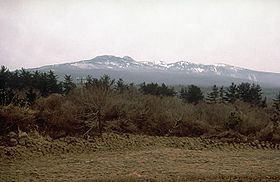Happy New Year!
Jeju Island
Beautiful things I saw on Jeju Island
|
Hello friends.
I hope you are well and happy at the beginning of this new year.
This month, I would like to show you some beautiful things I found in Jeju,
Korea.
My husband and I went there in December. It was the second Jeju trip for
my husband , and the first for me.
Our Korean friends, Mr. and Mrs. Park YoungHae invited us to join their
Jeju visit. They have been there many times, and said they would guide
us there.
We stayed at a nicest hotel, and had nicest meals. But I am not going to
boast of those expensive things. I will tell you about very small things
which deeply impressed me with their beauty. Natural beauty, philosophical
beauty, artistic beauty...
Please enjoy.
|
|
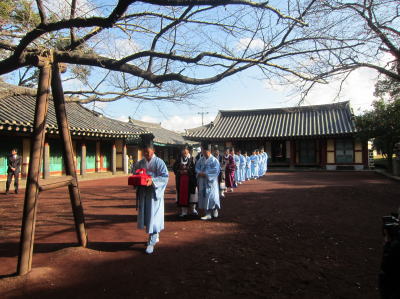 |
The kingdom of Tamna or Tamna guk ruled Jeju Island from ancient times until it
was absorbed by the Korean Joseon Dynasty in 1404.
One legend tells that the three divine founders of the country—Ko, Yang
, and Bu —emerged from three holes in the ground in the 24th century BC.
These holes, known as the Samseonghyeol (삼성혈), are still preserved in Jeju City.
We were quite lucky to be able to see the annual ceremony at the shrine
for the ancestors of these three clans of Ko, Yang and Bu.
The Governor of Jeju played the role of the priest. (the black costume person)
The ceremony was fascinating. |
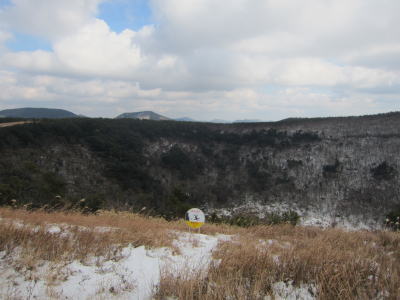 |
Sangumburi Crater is the crater of
an extinct volcano. Unlike its brethren Halla-san and Songsan Ilch'ubong, this
one exploded quickly, but did not spew much lava nor did it form much of a
surrounding cone.
Over 400 species of plants and animals live inside the crater.
It was an amazing scene. I waited for the rare animals to appear, but in
vain. Too cold.
Maybe someday, I will be back to see those dear living things. I will need
scopes. |
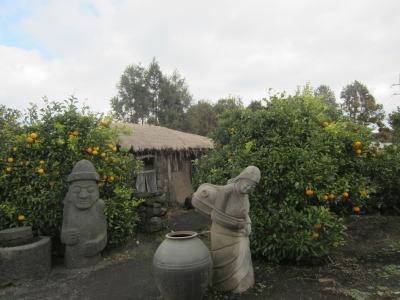 |
A small house in an orange orchard. Please see the woman's statue. In Jeju,
it was the custom that only women worked and men did not. There is no river,
nor underground water because this is a volcanic land, so women had to
work hard to carry water from a pond of rain water.
On the left, you see a dol hareubang (stone grandfather). Here in Jeju, we see many grandfathers. Mrs. Park
told me that the one whose right hand is at the upper position than the
left hand is a literary officer, and the opposite is a military officer.
I wanted to buy one literary grandpa, but who carries this heavy stone
man? |
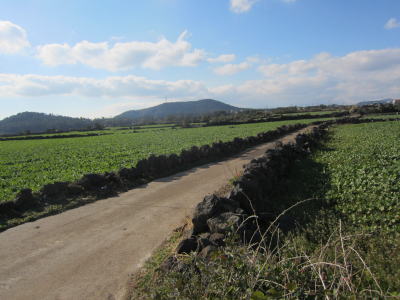 |
All around Jeju Island, you will see stone walls protecting fields and
houses from the strong winds from the sea.
These rocks are basalt (volcanic rocks). They are also used for building
houses, or any other structures. Each stone has a face, and it is attractive.
Smiling rock, weeping, or in anger. Maybe because these stones have many
holes on the surface and they look like eyes, nose, and mouth. |
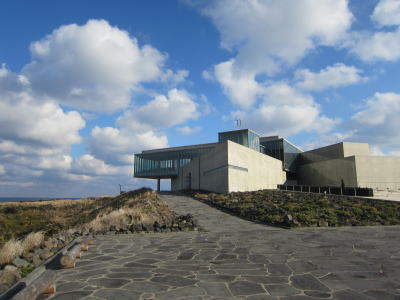 |
The Glass House (cafe) designed by a famous Japanese architect, Tadao Ando.
It was my first experience to see the round horizon of almost 300degrees
wide from the window of this cafe. The panorama was amazing. We had traditional
Korean tea there. Hot and soothing. |
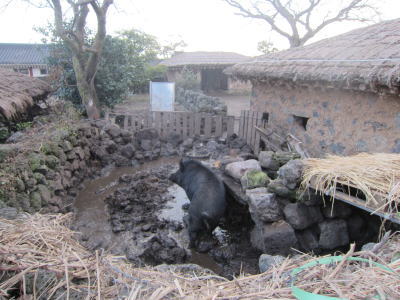 |
Please see the photo carefully. You will find a black pig in the center.(back
figure)
The black pig is a unique specie of Jeju Island.
In old days, pigs were kept in this type of hole in the ground, circled
with the stones, with one part thatched with pampas grass for sleeping,
and another part, which is a toilet for men, and at the same time feeding
the pig. You can imagine what the pigs ate. What a wonderful cycle of life!
Black pig is so famous for its taste. Many people go to Jeju Island to
eat this.
In Kagoshima Prefecture, Kyushu Japan, also the black pig is famous. But
Kagoshima black pig is different, having six white spots on four paws,
nose and the tail. |
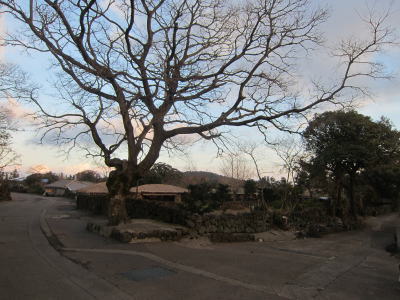 |
Village scenery looks like Japanese small country villages, with a big
tree to guard the house from demons. |
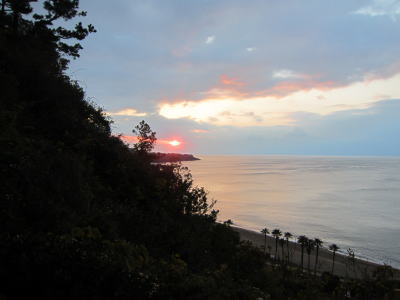 |
Sunrise seen from the hotel window. |
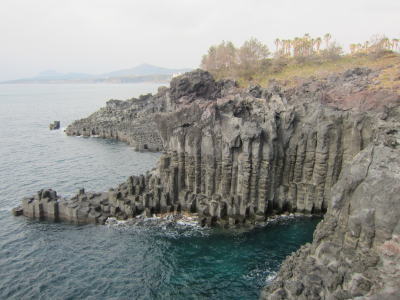 |
The sea shore of this volcanic island is not a sandy beach, but everywhere,
Columnar jointed basalt is seen.
In Karatsu, we have similar thing.
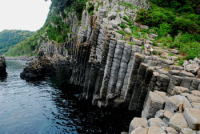
Karatsu Seven Caves |
|
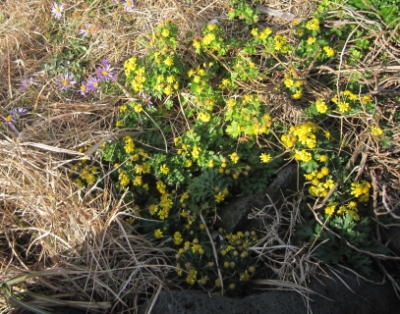 |
On the cliff of the joint basalt, small flowers were clinging to each other
to protect themselves from the hard winds. |
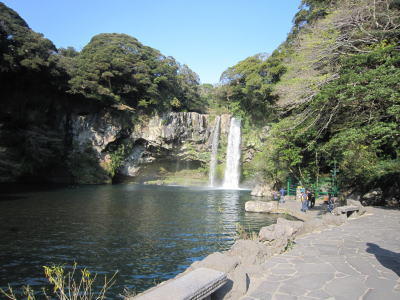 |
The Cheonjiyeon Waterfall.
There is no river on top of the cliff of the waterfall. The water is emerging
from the underground. In summer, the quantity of water is much bigger than
in winter. From here to the sea, water travels a short river.
There are some other waterfalls in this island, of which water falls directly
onto the sea. But we had no time to see them. |
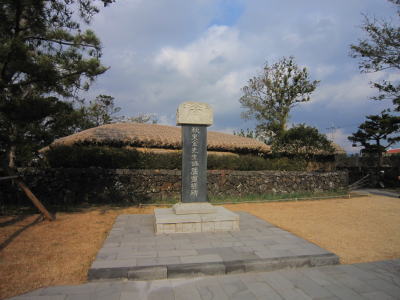 |
The brilliant scholar Kim Jeoung Hui lived his exiled days in despair here. The museum shows his calligraphy
and paintings. We were glad to see them. We had once seen his works at
a museum in Seoul.
during the dynasties of Korea, many able persons were exiled at the change
of kings only by political reasons. Even now it happens in the world. When
do we learn from the history?
|
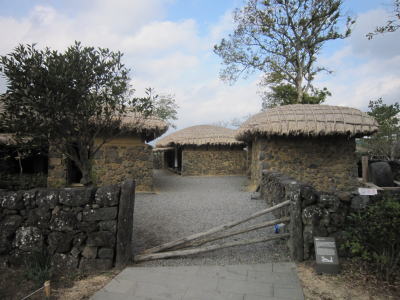 |
The house where Kim Jeong Hui lived.
The three timbers of the gate is a special sign unique to Jeju Island.
This shape means that the guests are welcome to the house. If all the three
timbers are horizontal, it means no body is at home and guest is requested
to come again later. |
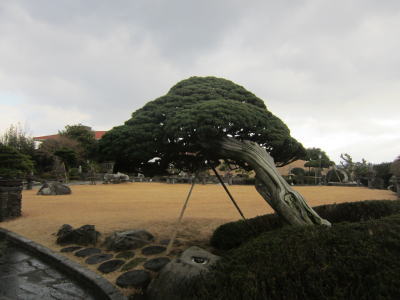 |
In the Bonsai Garden Park, we saw old trees of miniature size. Each tree
had a story.
A four hundred years old tree, the stem half dead, protected with calcik
paint, was like an old philosopher talking about the cycle of life. |
|
Our trip this time was too short to see the natures of all kinds in Jeju.
You can go and see yourself the UNESCO's World Legacy island of wind and
rocks.
This time, we could see the top of Mt. Halla only for 3 minutes. It was
covered with snow, and too soon, the clouds hid the mountain again.
Maybe in summer, we will return.
Thank you for visiting this site, and I hope I will see you next month
again.
|

